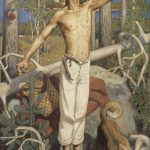
In Paris, Schjerfbeck painted with Helena Westermarck, then left to study with Léon Bonnat at Mme Trélat de Vigny’s studio. In 1881 she moved to the Académie Colarossi, where she studied once again with Westermarck.
The Imperial Senate gave her another scholarship, which she used to spend a couple of months in Meudon, and then a few more months in Concarneau, Brittany. She then went back to the Académie Colarossi briefly, before returning to the Adlercreutz family manor in Finland.
Schjerfbeck continued to move around frequently, painting and studying with various people. Schjerfbeck made money by continuing to put her paintings in the Art Society’s exhibitions. She also did illustrations for books. In 1884 she was back in Paris at the Académie Colarossi with Westermarck. This time they were working there.
She was given more money to travel by a man from the Finnish Art Society and in 1887 she traveled to St Ives, Cornwall, in Britain. There she painted The Convalescent. It won the bronze medal at the 1889 Paris World Fair. The painting was later bought by the Finnish Art Society. During this period Schjerfbeck was painting in a naturalistic plein-air style.
In the 1890s Schjerfbeck started teaching regularly in Finland at the Art Society drawing school, but in 1901 she became too ill to teach. In 1902 she resigned her post. She moved to Hyvinkää, all while taking care of her mother who lived with her (the mother died in 1923).
Isolation in Hyvinkää
While living in Hyvinkää, she continued to paint and exhibit. “Schjerfbeck’s sole contact with the art world was through magazines sent by friends.” Since she did not have art, Schjerfbeck took up hobbies like reading and embroidery.
During this time Schjerbeck produced still lifes and landscapes. She also created portraits, such as that of her mother, local school girls and women workers, and self-portraits.
Her work has been compared to that of artists such as James McNeill Whistler and Edvard Munch, but from 1905 her paintings took on a character that was hers alone. She continued experimenting with various techniques such as using different types of underpainting.
In 1913 Schjerfbeck met the art-dealer Gösta Stenman, with whose encouragement she exhibited at Malmö in 1914, Stockholm in 1916 and St Petersburg in 1917. In 1917 Stenman organized her first solo exhibition and in that year Einar Reuter (alias H. Ahtela) published the first Schjerfbeck monograph.
Later she exhibited at Copenhagen (1919), Gothenburg (1923) and Stockholm (1934). In 1937 Stenman organized another solo exhibition for her in Stockholm, and in 1938 he began paying her a monthly stipend. Source: Wikipedia.




